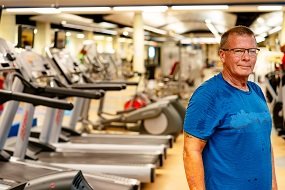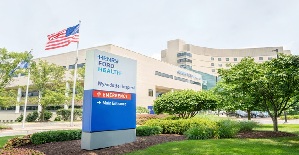Life after Joint Replacement

DETROIT – He works out at the local YMCA five days a week, plays hockey with men much younger and, for good measure, enjoys extreme mountain hunting.
For those dubious about their quality of life after joint replacement surgery, Tom Blenkhorn is cheering you on.
“Don’t be scared of it,” says Blenkhorn, who has had both hips replaced and shoulder surgery for a torn rotator at Henry Ford West Bloomfield Hospital in the past three years. “You’ll be amazed at how much you’ll feel better.”
Blenkhorn is among the more than 1 million people who undergo total joint replacement, also known as total joint arthroplasty, every year, according to the American Academy of Orthopaedic Surgeons. The AAOS predicts that number to reach 4 million by 2030.
Pain and disability often lead people to surgery.
During the surgery, the damaged cartilage and bone is removed from your joint and replaced with prosthetic components made of metal, plastic, or ceramic. The prosthesis mimics the shape and movement of a natural joint.
After surgery, most Henry Ford joint replacement patients return home the same day; others may stay overnight in the hospital before going home. Patients typically return to their normal activities in four to six weeks. It may take up to four to six months to be fully recovered from surgery.
Blenkhorn was referred to Henry Ford joint replacement surgeons after doctors near his home in Frankenmuth were skittish about taking on the surgery given the brittle condition of his right hip. Blenkhorn had the hip replaced in March 2016; one later he had the left one done.
Joint replacement surgeon Trevor Banka, M.D., who performed each of Blenkhorn’s hip replacements, says 20 percent of his practice comprises complex joint replacement cases. He described Blenkhorn’s right hip as uncommonly deformed for someone his age – Blenkhorn recently turned 60. He was also remarkably struck by the patient’s ambition after surgery.
“He told me he ne eded the surgery so he could carry a ram off the mountain on a donkey,” says Dr. Banka, adding the procedure “went very smoothly.”
eded the surgery so he could carry a ram off the mountain on a donkey,” says Dr. Banka, adding the procedure “went very smoothly.”
Before hip replacement surgery, Blenkhorn remembers living with debilitating pain – level nine on the pain meter – and taking eight to 10 ibuprofen pills daily. Four months after the first surgery, Blenkhorn was skating pain free for the first time in five years. He calls Dr. Banka his “miracle worker.”
“It’s my goal at surgery to give my patients their life back,” Dr. Banka says, “so they can do what they want to do without pain.”
He says Blenkhorn’s desire to return to an active lifestyle is a “great example of what you want in a patient.”
Now with titanium hips and a rebuilt shoulder, life is blissful for Blenkhorn. The husband and father of three children retired four years ago after owning a janitorial company, which required out-of-town traveling 45 weeks of the year. Last fall, he completed a 19-day hunt for goats in British Columbia, a physically demanding trek for anyone lest one who is two years removed from hip and shoulder surgery. He’s also overjoyed with the mundane task of being able to bend over and lace up his skates for the 18 and older ice hockey league he plays in.
“I feel like a million bucks,” he says. “I feel better now than I’ve felt in 30, 40 years.”
###
MEDIA CONTACT: David Olejarz / David.Olejarz@hfhs.org / 313.874.4094
.svg?iar=0&hash=F6049510E33E4E6D8196C26CCC0A64A4)

/hfh-logo-main--white.svg?iar=0&hash=ED491CBFADFB7670FAE94559C98D7798)







